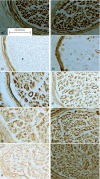Extracellular matrix remodelling in human diabetic neuropathy
- PMID: 19207983
- PMCID: PMC2667879
- DOI: 10.1111/j.1469-7580.2008.01026.x
Extracellular matrix remodelling in human diabetic neuropathy
Abstract
The extracellular matrix of peripheral nerve plays a vital role in terms of normal nerve fibre function and also in the regenerative response following nerve injury. Nerve fibre loss is a major feature of diabetic neuropathy; however, the regenerative response is limited and this may be associated with changes in the composition of the extracellular matrix. Glycoproteins and collagens are major components of the extracellular matrix and are known to be important in terms of axonal growth. This work has therefore examined whether changes in the expression of two major glycoproteins, laminin and tenascin, and three collagen types (IV, V and VI) occur in the endoneurial and perineurial connective tissue compartments of human diabetic nerve. Despite being known to have a positive effect in terms of axonal growth, laminin levels were not elevated in the diabetic nerves. However, the pattern of tenascin expression did differ between the two groups being found in association with axon myelin units in the diabetic samples only. The pattern of collagen IV expression was the same in both tissue groups and was not found to be up-regulated. However, levels of collagen V and VI were both significantly increased in the endoneurium and for collagen VI also in the perineurium.
Figures


Similar articles
-
The extracellular matrix of peripheral nerve in diabetic polyneuropathy.Acta Neuropathol. 2000 May;99(5):539-46. doi: 10.1007/s004010051158. Acta Neuropathol. 2000. PMID: 10805099
-
A quantitative analysis of perineurial cell basement membrane collagen IV, laminin and fibronectin in diabetic and non-diabetic human sural nerve.J Anat. 2002 Aug;201(2):185-92. doi: 10.1046/j.1469-7580.2002.00083.x. J Anat. 2002. PMID: 12220126 Free PMC article.
-
Relationship between fascicle size and perineurial collagen IV content in diabetic and control human peripheral nerve.Histopathology. 2000 Jun;36(6):551-5. doi: 10.1046/j.1365-2559.2000.00897.x. Histopathology. 2000. PMID: 10849098
-
Extracellular matrix of peripheral nerves in diabetes.J Peripher Nerv Syst. 1997;2(3):213-26. J Peripher Nerv Syst. 1997. PMID: 10975727 Review.
-
Role of the Schwann cell in diabetic neuropathy.Int Rev Neurobiol. 2002;50:293-321. doi: 10.1016/s0074-7742(02)50081-7. Int Rev Neurobiol. 2002. PMID: 12198814 Review.
Cited by
-
Genome-wide profiling of DNA methylation and gene expression identifies candidate genes for human diabetic neuropathy.Clin Epigenetics. 2020 Aug 12;12(1):123. doi: 10.1186/s13148-020-00913-6. Clin Epigenetics. 2020. PMID: 32787975 Free PMC article.
-
Characterization of Endoneurial Fibroblast-like Cells from Human and Rat Peripheral Nerves.J Histochem Cytochem. 2014 Jun;62(6):424-435. doi: 10.1369/0022155414530994. Epub 2014 Mar 26. J Histochem Cytochem. 2014. PMID: 24670794 Free PMC article.
-
Diabetes-related intestinal region-specific thickening of ganglionic basement membrane and regionally decreased matrix metalloproteinase 9 expression in myenteric ganglia.World J Diabetes. 2021 May 15;12(5):658-672. doi: 10.4239/wjd.v12.i5.658. World J Diabetes. 2021. PMID: 33995853 Free PMC article.
-
The pattern of tibial nerve excursion with active ankle dorsiflexion is different in older people with diabetes mellitus.Clin Biomech (Bristol). 2012 Nov;27(9):967-71. doi: 10.1016/j.clinbiomech.2012.06.013. Epub 2012 Jul 17. Clin Biomech (Bristol). 2012. PMID: 22809735 Free PMC article.
-
[Update on diabetic macroangiopathy].Pathologe. 2012 May;33(3):192-204. doi: 10.1007/s00292-011-1554-8. Pathologe. 2012. PMID: 22576595 Review. German.
References
-
- Bradley JL, Thomas PK, King RMH, Watkins PJ. A comparison of perineurial and vascular basal laminal changes in diabetic neuropathy. Acta Neuropathol. 1994;88:426–432. - PubMed
-
- Bradley JL, Thomas PK, King RHM, et al. Myelinated fibre regeneration in diabetic sensory polyneuropathy: correlation with type of diabetes. Acta Neuropathol. 1995;90:403–410. - PubMed
-
- Bradley JL, King RHM, Muddle JR, Thomas PK. The extracellular matrix of peripheral nerve in diabetic polyneuropathy. Acta Neuropathol. 2000;99:539–546. - PubMed
-
- Carbonetto S. The extracellular-matrix of the nervous system. Trends Neurosci. 1984;7:382–387.
MeSH terms
Substances
LinkOut - more resources
Full Text Sources
Medical

